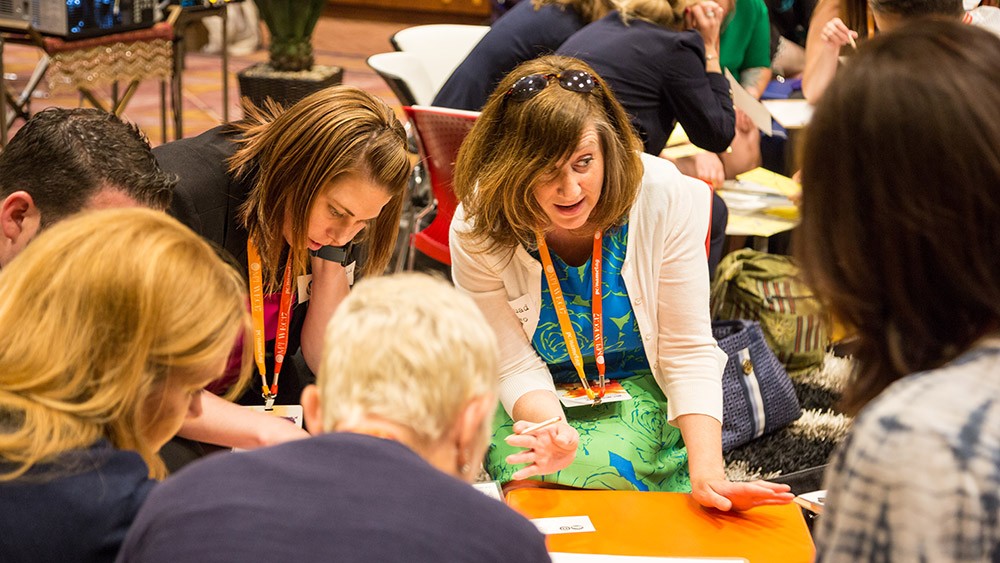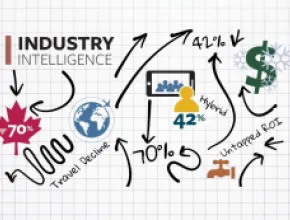From fish bowls and hackathons to bean bag brainstorms and outdoor walking sessions, the attendee experience has come a long way from the ho-hum theater-style setup and drab PowerPoint presentation.
Designing programs that truly involve attendees in novel and inspiring ways is the key to successful meetings nowadays. Some of the latest trends to help keep attendees engaged involve interactive learning formats, creative physical setups and local inspiration.
Jessie States, manager of professional development for MPI, has been busy helping meeting professionals discover alternative strategies for designing distinctive and collaborative learning sessions for groups, particularly through events such as the annual MPI-WEC and various MPI chapter conferences.
“Planners need to design different formulas to help people engage, so we’ve been experimenting with various formats with them so they can see how best to implement them at their own events,” States said.
Among the many innovative learning formats that have been the most well received, according to States, are fish bowls, dotmocracies, spectrograms, story slams and space races.
1. Mastering the Fish Bowl Format
A fish bowl format allows meeting professionals to create a truly intimate conversational experience with large groups of people.
“It’s an incredibly good opportunity to engage your marketplace in a unique way,” States said.
The session can be organized by placing four chairs in the center of the room with concurrent circles of seats surrounding it to create a “fish bowl.”
“Suggest a topic of conversation, or have one pre-determined, and invite three people (the “fish”) to come and begin the discussion,” States said. “Anyone from the bowl may join the fish at any time by sitting in the empty chair, and one of the existing fish will voluntarily leave.
“Rinse and repeat as desired with any number of questions or topics,” she added.
2. Stage a ‘Great Dotmocracy’
Meanwhile, starting an event with a “Great Dotmocracy” is a unique way to discover what audience members want to address while they are onsite at your meeting or event, according to States, from the greatest problem facing a company to a hot industry issue affecting attendees’ bottom lines.
“Brainstorm a variety of different topics or challenges and have a volunteer scribe record them on flip chart pages,” States said. “Tape the pages on the walls of your session room.
"Using color coding labels, ask your participants to vote using their ‘dots’ on which topics they wish to address, then break them into groups to problem-solve, address and/or discuss the highest-rated topics," she added.
3. Spectogram Learning Technique
Another novel interactive learning approach is the spectrogram, which is a great way for attendees to gain new perspectives and even source a live expert panel from the audience, according to States.
“Ask participants to line up in your space according to set criteria that forces them to make a choice,” she said. “For example, ask your attendees to choose meat or vegetable—“all meat” attendees and “all veggie” attendees will stand at the extremes, with all others standing somewhere in between.
“No one can choose the middle,” States added. “Then, ask those on the far ends of your line why they have made such an assertive position. See if you can move the attendees towards the middle.”
To source experts in the room, States said you can ask your audience to stand in a line based on their subject matter expertise on a topic.
“Find your experts and ask them questions, or even ask them to sit on an impromptu panel while attendees work in groups to come up with questions for your experts,” she said.
4. Experiential Storytelling
Meanwhile, storytelling is an impactful way for attendees to share their experiences and learn from those of others, according to States. In a story slam format, she said, audience members can present best practices, innovations or even “horror stories” to their peers.
“Set a line up or have an open mic (with a couple of stories pre-planned to help your audience feel comfortable with the format) and see how your attendees laugh, cry and learn together,” States said.
“Or create a sponsorship program and offer the time to your suppliers to share real-life stories about how they have turned a customer’s challenge into an amazing opportunity—just make sure that they know the difference between stories and pitches,” she added.
5. Hold a Space Race
Another interesting way to truly involve delegates is through a space race, according to States. The format offers learners the opportunity to create their own educational environment, giving them a sense of ownership over what happens in the room.
“Place all of the (light-weight) furniture and decor in the center of the space before the start of your meeting (check if union rules apply),” States said. “For small programs up to 15 people, assign jobs to groups—such as signage, seating and decor—and have them work together to design a custom learning environment.
"For larger events up to 50, assign teams to design a space on a flip-chart or butcher paper and present it out.”
In the end, everyone votes to come up with the winning environment, and the winning team manages the execution of the space.
6. Become a 'Meetovator'
Unique ways to encourage active involvement and participation among attendees is also one of the cornerstones of the Meetovation concept created by Visit Denmark.
Hector Venegas, managing director of Engaging Meetings, with offices in Germany and Denmark, trains planners to become Meetovators through the concept.
“People learn by doing not by listening, and studies repeatedly show that participants gain more from the meeting when they are involved in the process,” Venegas said.
One format he suggests to actively engage attendees, introduce them to one another or discuss different topics is speed dating.
“Make your participants form two lines facing each other, and every two minutes ask everyone to shift two places, allowing 30 minutes total,” he said. “If you have a lot of participants, you can divide them into smaller groups.”
7. Stimulate the Senses
The creative setup is another important Meetovation principle, according to Venegas.
“If you just put rows of chairs, nobody will talk to each other,” he said. “When you use the physical environment in new ways, it will motivate your participants.”
Venegas suggested creating inspiring interiors to stimulate all the senses with lights and aromas or designing a session outdoors in a forest or a walking meeting with a small group.
“Anything is possible, as long as the physical environment will generate energy, concentration and creativity,” he said.
8. Change Up the Setting
Venegas said changing the setup of a room after lunch, for example, is one way to surprise and delight attendees.
“For one conference, we had 150 people in a room, and since we know the energy of a meeting always goes down after lunch, we had a completely different setting when the participants came back—bean bags,” Venegas said. “They were all asked to grab one and we had a presenter explain how to power nap.
“Some slept for 15 minutes, others relaxed, but everyone was reenergized and ready to absorb more great content after that,” he added.
9. Add Some Local Inspiration
Meanwhile, planners must always keep local inspiration in mind when designing meetings, Venegas said, particularly since attendees choose conventions and other events based on the destination where it is being held.
“Local inspiration is a very important tool,” he said. “Why would you do an event in Tokyo if it weren’t part of the event? When you let the local surroundings play a part in your meeting, conference or event, you are giving participants a very unique experience they will remember for both personal and professional reasons.”
Venegas said the obvious way to incorporate local experiences is to arrange visits to the destination’s attractions, let the local cuisine be a major part of the catering experience, and incorporate local art and entertainment. But he said utilizing local experts for keynotes, for example, is another great strategy.
“Above all, matching the objectives of the meeting is key when considering local attractions, environments and experts, so the local input can support the purpose and topic of the meeting,” he said.
“So for example, if you are doing a meeting about growth, you should take participants to a place where they can taste growth—the mountains if they are meeting in Alberta, for instance."
10. Give Thoughtful Gifts
Venegas said another great way to leave a lasting impression with local inspiration is through gifts.
“If you give presents to the participants, let it be something special from the destination, not just another pen,” he said. “For example, after I attended the Finnish MPI chapter meeting, they gave me a cup and a tea towel from the famous Finnish textile designer Marimekko.
“I love that gift and every time I use both of them I think warmly of my experience there and the meeting."
[Read This Next: 9 Self-Care Tips to Maintain Your Sanity at Conferences]







